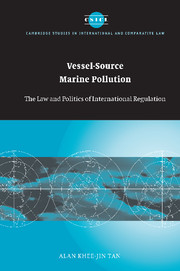Book contents
- Frontmatter
- Contents
- Foreword
- Preface
- Table of Conventions
- Table of European Union Instruments
- Table of IMO Resolutions and Guidelines
- Table of Miscellaneous Instruments
- Table of Domestic Legislation
- Table of Cases (International Courts and Tribunals)
- Abbreviations
- Part A The Regulation of Vessel-Source Pollution in its Eco-Political Context
- Part B Vessel-Source Pollution and the International Legislative Process
- 3 Vessel-Source Pollution and Regime Formation
- 4 Jurisdiction over Vessel-Source Marine Pollution
- 5 Implementation and Compliance
- 6 Liability and Compensation
- Part C The Future of Regulation
- Bibliography
- Index
- CAMBRIDGE STUDIES IN INTERNATIONAL AND COMPARATIVE LAW
3 - Vessel-Source Pollution and Regime Formation
Published online by Cambridge University Press: 24 July 2009
- Frontmatter
- Contents
- Foreword
- Preface
- Table of Conventions
- Table of European Union Instruments
- Table of IMO Resolutions and Guidelines
- Table of Miscellaneous Instruments
- Table of Domestic Legislation
- Table of Cases (International Courts and Tribunals)
- Abbreviations
- Part A The Regulation of Vessel-Source Pollution in its Eco-Political Context
- Part B Vessel-Source Pollution and the International Legislative Process
- 3 Vessel-Source Pollution and Regime Formation
- 4 Jurisdiction over Vessel-Source Marine Pollution
- 5 Implementation and Compliance
- 6 Liability and Compensation
- Part C The Future of Regulation
- Bibliography
- Index
- CAMBRIDGE STUDIES IN INTERNATIONAL AND COMPARATIVE LAW
Summary
Pollution Control Standards and Reception Facilities
Early Regulatory Efforts
One of the most important concepts employed in the regulation of vessel-source pollution is that of controlled discharges within ocean zones. The concept can be traced back to the early part of the twentieth century when political pressure in the UK and the US led to regulation over oily waste discharges (mainly by non-tankers) beyond the traditional three-mile territorial waters limit. Subsequently, international agreement was sought on the matter, and a conference was convened in Washington DC in June 1926 for this purpose. For the UK and the US, international agreement was needed to avert unilateral action by other states and to avoid competitive disadvantages for their own merchant fleets.
At the Washington conference, the UK and the US were able to persuade other states to adopt pollution control zones of up to 50 nautical miles from shore. Within these zones (which states could declare at their discretion), ship discharges beyond 500 parts per million (ppm) of oil to water were prohibited. This formed the genesis of the ‘ppm’ discharge standard and the ‘prohibition zone’ concept so widely prescribed in later conventions. In advocating a zonal approach, the UK and the US had to assure the other states that international law remained unaltered and that flag states retained jurisdiction over their vessels, even within the prohibition zones. For the first time, a pollution control measure was to be introduced beyond territorial limits in areas then considered to be high seas.
- Type
- Chapter
- Information
- Vessel-Source Marine PollutionThe Law and Politics of International Regulation, pp. 107 - 175Publisher: Cambridge University PressPrint publication year: 2005



